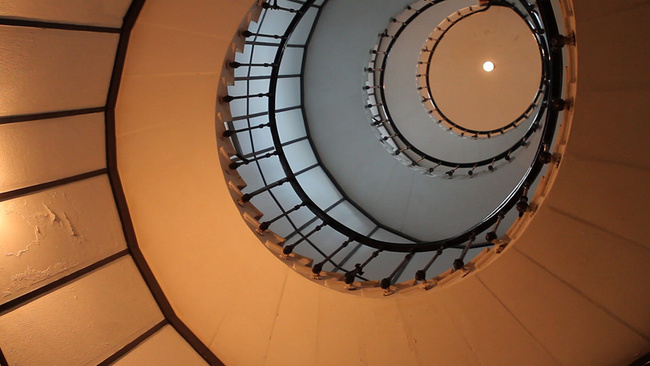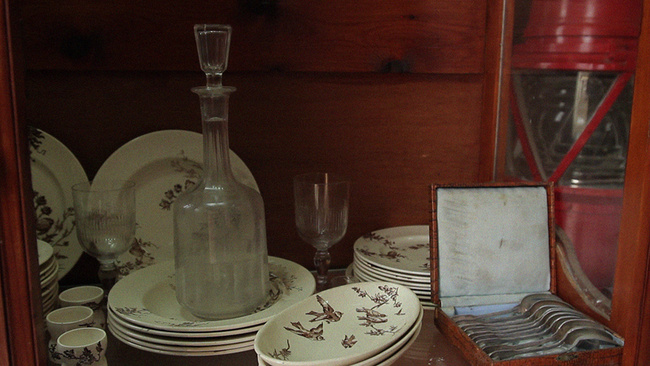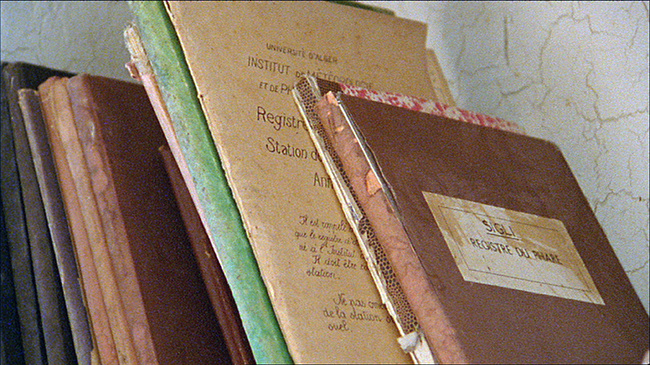Zineb Sedira's Lighthouse in the Sea of Time comprises a series of videos and photographs documenting the artist's journeys to two lighthouses in Algeria: Cap Caxine, which lies just outside the capital city of Algiers, and Cap Sigli, located in the more remote Berber region called Kabylia. Built and maintained by France when Algeria was a colonial outpost, the buildings transferred to Algerian control following the Algerian War for Independence (1954–1962). The work unfolds in multiple, interrelated parts to frame the lighthouses' technologies, archives, and keepers, who clearly derive profound satisfaction from their monastic routines. Along with the Mediterranean Sea, the quiet poetics of watching, guarding, and caretaking envelop the lighthouses as historical sites and demonstrate the subtle persistence of struggles over nationhood, asylum, cultural identity, and language.
Zineb Sedira: Lighthouse in the Sea of Time was on view at Blaffer Art Museum at the University of Houston from October 4 to December 14, 2013. On October 3, I moderated a conversation between Zineb Sedira and Ranjana Khanna, Director of Women's Studies and Professor of English, Literature, and Women's Studies at Duke University. Following is an edited transcription.
—Amy Powell
Art Lies Editor
Amy Powell: In Lighthouse in the Sea of Time and in your past work, you've been interested in different ways of narrating history, drawing on oral narratives and interviews, and also working with material and photographic archives. How do you see these modes or resources in relation to one another, and how does memory function in the work as a result?
Zineb Sedira: Lighthouse is indeed a composite of my interests in oral history and storytelling, but also of listening and collecting the stories, which is in some ways more important for me. I'm realizing more and more my very strong interest in memory, because for a long time I felt I was surrounded by a lack of memories. My parents were born and lived in a remote part of Algeria, which was French. At the time, there was no school for Algerians. They could not read nor write and their knowledge of their country was deficient. You have to imagine the context of colonization at the time, especially in rural places. My parents never had much to tell us about Algeria as there had been a lot of suffering. My parents' accounts and their memory of Algeria were really important for shaping my own identity, which was of course French, as I grew up in France, but Algerian, too. A lack of narrative made me really seek it out. As I grew older, and as I became a mother myself, I wanted to record their memories and stories.
Ranjana Khanna: There are state reasons for a lack of memory as well. The Evian Accords that were in place at the end of the Algerian struggle, war for independence, revolution—whatever you want to call it—the laws that were put in place by the French shut down memory because no one was going to be held accountable for what they had done during that period. Amnesty brought about amnesia. So there was a kind of silence that many have written about now, many years later, a kind of amnesia in the French psyche as well as in the Algerian psyche around the war, but also of the whole history of colonialism. The colonial history is everywhere in the literature, in the arts, and yet it's not there as a memory of the way people lived in the Algerian context. The question you asked around the archive is of course related to this, and formally related in Zineb's installation, because it seems as if on one level the lighthouse is a witness of something. And what the lighthouses witness is unclear because it has only human forms of documentation, apart from the fact that the lighthouses are externally weathered.
ZS: It's true that France (at the time, anyway, it's changing, slowly, but it is changing) hasn't allowed for a certain type of memory. Naïvely, for a long time I thought it was only a problem in France. I understand now that there is another problem in Algeria of retaining its own history and its own memory. Doing this piece with the lighthouses was a way of looking at these issues. It's about French colonization, but it's also about this kind of local neglect of Algeria's own history and heritage. You can see in my previous works Saphir (2006) and Haunted House (2006), for example, there are a lot of really interesting buildings in Algeria that are totally neglected, and the local people don't see them as part of history anymore, but instead as threatening and separated from their past. I'm trying to bring some of these elements back to life, literally, by giving them a form of beauty and interest, hoping to preserve their stories. Perhaps I can do that because I am an Algerian who grew up in France. Gardiennes d'images (2010) is a film I made about a photographic archive of an Algerian photographer, Mohamed Kouaci, whose work is extremely important for the history of Algeria and France. Kouaci was the only Algerian photographer who took photos of the Algerian war. Almost all the images we have of that period are from the French army or from the photo journalists invited by the French, so the photographs conveyed a very particular angle of one side's story. Kouaci was coming from inside, from Tunisia, and was able to access places differently than many French journalists. Kouaci is dead now, and he left the archive to his wife Safia Kouaci. But the government in Algeria is not doing anything about the archive, and it's slowly dying. France and Algeria are neglecting Algerian history and identity.
AP: One of the most striking features of the work is its framing. Lighthouse in the Sea of Time unfolds in multiple parts video and photography—a four-channel video projection, two monitors with four videos between them, and photographs showing the lighthouse keepers' logbook (which is also referenced in the videos) and a museum with lighthouse technologies and objects on display. Zineb, how did you decide to structure the work in this way? And Ranjana, could you speak about the frame as a concept as it relates to your work?
ZS: The four-screen video piece and The Life of a Lighthouse Keeper video were commissioned for the Folkestone Triennial in 2011, and only that part of the work was shown there. After returning from Algeria and looking back at the footage, I decided to extract other elements. I made the videos La Montée, Names Through Time: A Keeper's Logbook and Handwriting Through Time: A Visitors' Book, and A Museum of Traces, and also the photographs. They were never meant to be shown together, but slowly it grew and other pieces were added. There is an element of repetition due to the way the work was made. Repetition is very important, as is the idea of obsession. When we listen to the interview in The Life of a Lighthouse Keeper, we can understand the lighthouse keeper's passion and his obsession for the lighthouse and for his work.
RK: I think the framing of this work is really fascinating. I've been thinking about frames in many different ways. In the context of art history and art theory, I suppose I'm quite shaped by Derrida's work Truth in Painting, where he talks about the frame and understands it through Kant, which is about the way a work is shaped and bordered by a frame that nonetheless can be permeated any time. The frame itself becomes part of the work, and there isn't really a distinction between the work and the frame. I've been thinking about the frame as a kind of bordering or questioning of hospitality and hostility—where you let something in, where you push something away, where you delimit something like a national border, or indeed, a national identity. Zineb, you started off talking about your parents and where they come from, and, in a sense, the rural setting being their local setting without really a conceptualization of Algeria as a whole. We think about Algeria as one space with its massive borders, but in fact, often the experience of Algerians will be very local and will not be broadened by the kind of framing that maps and colonial histories produce. Of course, Algeria was not just a colony of France, it was part of France. Algeria was three counties, one could say, or departments of France. How things get demarcated by frames at certain points and how they shift is itself really fascinating in terms of questions of who's allowed in, who's pushed out, and what the artwork speaks to, whether Algeria, France, or Britain. In terms of Lighthouse's frames, none of these geographical categories are entirely relevant in the way that the work is framed. I'm by no means the first person to say this, but there's a way in which video addresses a migratory aesthetic by always pushing against its own frame, always being on the move, as it were. In your work, and in works by other contemporary artists, there is a way of trying to think video beyond and with a frame.
AP: Zineb, how did you think about the lighthouse as a frame, as Ranjana is saying? As a border marker or a point of entry?
ZS: The fact that they are both is what interested me in the lighthouses: they are witnesses to time and a certain history of Algeria. These lighthouses are still looked after by lighthouse keepers, and this triggered my interest to record the story of their profession, which might not exist in ten years. I'm increasingly interested in what is not in the frame and what is excluded. The editing or the censorship that happens when I make film or photography leads me to wonder what would happen if I were showing raw footage that I haven't included in the finished work. Framing, for me, is concerned with the fragility of a certain type of memory, which is something that I'm interested in.
RK: But then the photographs are a kind of excess as well, of what video can't contain or indicate in its framing. We can dwell on the photographs. I suppose you can freeze the video—you can freeze something digital that you can't with film in quite the same way, without damaging it.
ZB: Yes, for example, in the series of photographs Museum of Traces and Registre du Phare, of the lighthouse logbooks, it was important for me to use photography because you can see that all the museum labels are written in French. In the video it is not as clear.
AP: Thinking further about technology, another striking element in the work is how the lighthouse becomes a technology for seeing, like film. In many ways they are both about projection and light as a kind of medium.
ZB: I guess that's why I wanted to shoot in film. Although it was difficult because the lighthouse is not easy to access due to its narrow stairs and high tower, and the medium of film requires large cameras and complex equipment. But to be honest, I didn't think too much about that aspect as I was more interested in what was happening there and then. A very important part of my practice is that, although I don't script much before I shoot, I always leave space for discoveries and intuitions. I discovered new elements when I was shooting that I hadn't anticipated, and so I included them. I thought about the relationship between the lighthouse and cinema—that's why I used film—but it wasn't part of the piece for me at the time. It would be interesting to hear what you have to say about that.
RK: I found your attention to technology quite an interesting aspect of it. In the four-screen installation, we see the lighthouse mechanics as the wheels and cogs go around, and the light as it moves. Early on, we see the light projecting into darkness, and it's very reminiscent of a film projector—the light being projected and us coming to an understanding of images through the projection of light. For me, it was also quite interesting to see how you used 16mm to recall a certain kind of technological moment in the development of cinema: the mechanization of time, because the lighthouse is like a clock going round. Each of the pieces in Lighthouse in the Sea of Time—the four-screen installation, the video piece with the interview, the piece called La Montée with Zineb going up the stairs, and the pieces with the lighthouse archives—have different ways of marking out time. Obviously your title "Sea of Time" is speaking to the question of temporality. And you transfer out of film by marking different technologies of living through history. In a sense, you unsettle the naturalization of any form of life by showing the way in which life has always been shaped by a certain technology, or at least in the histories that you're talking about. Whether through handwriting and the changes in the lighthouse keepers' and lighthouse visitors' handwriting that then become photographed, or through moments when you see the light being projected, there's a shift away from anything like a naturalization of any kind of life, or sense of normality. The lighthouse keeper is exactly recording what he does during the day, what the job entails. And he talks about work time and leisure time in more or less the same way, although it's not very clear whether there is that much leisure time because he sleeps with one eye open to check that the light is going around. But then he describes how he paints as well. It all seems to be part of his marked-out routine that is all dependent on diurnal time, which itself gets shaped through technology. Even though, of course, we know that day and night have to do with the sun and the earth's movement around it.
To read the rest of this conversation, please purchase the issue here.
Find the original 2013 Blaffer Art Museum exhibition page here.



